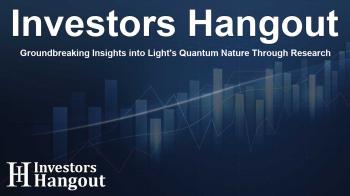Groundbreaking Insights into Light's Quantum Nature Through Research

Revolutionizing Our Understanding of Light's Nature
The quest to understand light has always been a fascinating journey. Light exhibits both wave-like and particle-like behaviors, creating a rich area of study in physics. A recent study, supported by Cheyney Design and Development, offers groundbreaking insights that may revolutionize our perception of light. This research is spearheaded by Dr. Dhiraj Sinha, a dedicated faculty member from Plaksha University.
Insights from Maxwell's Equations
For over a century, the scientific community has maintained that the dual nature of light is profoundly rooted in physics. Maxwell's theoretical framework in 1865 provided initial clarity on light's wave properties, affirming these insights through Heinrich Hertz's experiments in 1887. However, this consensus faced challenges with the emergence of the photoelectric effect, creating a divide in understanding.
Challenges to Classical Theories
When light interacts with metals, it generates electrons, thus countering Maxwell's propositions about light behavior. Albert Einstein's pivotal 1905 work introduced the notion that light consists of particles known as photons. His assertion—where the energy of these photons relates to their frequency—offered a new lens through which to view light, forming the basis for the widely accepted duality of light today.
Dr. Sinha's Innovative Research
Dr. Sinha's innovative research builds upon this foundational knowledge, aiming to bridge photons and electromagnetic fields as described by Maxwell. By investigating the time-dependent magnetic fields of light, he unveils how they generate electric potentials in space. This perspective suggests that electrons become energized through these electric potentials, thereby linking classical electromagnetism with quantum mechanics.
An Energy Transfer Revolution
Mathematically expressed, the energy transfer of electrons is defined in terms of changing magnetic flux over time. Such equations suggest the energy an electron absorbs aligns closely with Einstein's photon energy equation, showcasing a concrete connection between these critical theories of light and electromagnetic interaction.
Support from the Scientific Community
The reception of Dr. Sinha's work has been overwhelmingly positive. Notable physicists like Richard Muller from the University of California Berkeley have commended his research, stating that it tackles fundamental issues in quantum physics. Others, including Steven Verrall and Jorge Hirsch, have echoed similar sentiments, indicating that Dr. Sinha’s unique approaches may provide fresh insights into semiclassical modeling of quantum systems.
Implications for Future Technology
This discovery stands to significantly impact future technological developments. By connecting electromagnetic principles to modern photonic technologies, new pathways may emerge for innovations in solar cells, lasers, and LEDs—all of which rely on quantum mechanical principles. The transformative potential of this research cannot be understated as it paves the way for an era of integrated radio-photonics.
A Journey of Discovery
Dr. Sinha reflects on how his research journey began during his doctoral studies at the University of Cambridge, with vital support from Cheyney. His experiences progressed during his postdoctoral studies at the Massachusetts Institute of Technology, enhancing the depth and breadth of his investigations that have led to this monumental discovery.
About Cheyney Design and Development
Cheyney Design and Development Ltd, based in Litlington, UK, has emerged as a frontrunner in X-ray inspection technology. Founded by Richard Parmee, the company is committed to advancing innovative solutions that hold transformative potential in both science and engineering initiatives.
Frequently Asked Questions
What is the main focus of Dr. Sinha's research?
Dr. Sinha's research focuses on bridging the principles of Maxwell's electromagnetic theory and the nature of light, proposing a new understanding of light's interaction with electrons.
How does this research impact future technology?
This research has significant implications for developing advanced technologies like solar cells, lasers, and light-emitting devices by integrating classical electromagnetism with quantum mechanics.
What did Einstein contribute to the understanding of light?
Einstein proposed that light consists of particles called photons, which have energy proportional to their frequency, challenging previous classical theories.
Why is Maxwell's theory foundational in understanding light?
Maxwell's equations provided the first comprehensive theoretical framework explaining light as an electromagnetic wave, laying the groundwork for modern physics understanding.
What role has Cheyney played in this research?
Cheyney Design and Development has provided critical support for Dr. Sinha's research, enabling transformative scientific exploration in the field of light and photonics.
About The Author
Contact Caleb Price privately here. Or send an email with ATTN: Caleb Price as the subject to contact@investorshangout.com.
About Investors Hangout
Investors Hangout is a leading online stock forum for financial discussion and learning, offering a wide range of free tools and resources. It draws in traders of all levels, who exchange market knowledge, investigate trading tactics, and keep an eye on industry developments in real time. Featuring financial articles, stock message boards, quotes, charts, company profiles, and live news updates. Through cooperative learning and a wealth of informational resources, it helps users from novices creating their first portfolios to experts honing their techniques. Join Investors Hangout today: https://investorshangout.com/
The content of this article is based on factual, publicly available information and does not represent legal, financial, or investment advice. Investors Hangout does not offer financial advice, and the author is not a licensed financial advisor. Consult a qualified advisor before making any financial or investment decisions based on this article. This article should not be considered advice to purchase, sell, or hold any securities or other investments. If any of the material provided here is inaccurate, please contact us for corrections.

